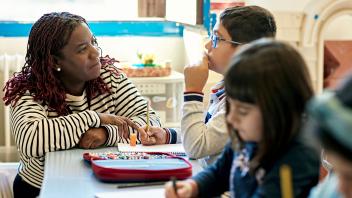Today’s schools must accommodate students from different ethnic groups, language groups, cultures, family situations, and social and economic situations, with different interests and purposes for learning, and different abilities and styles of learning.
In the face of all this diversity, schools can no longer operate as if one curriculum and way of teaching will fit most of the students. Instead, students can pursue a common set of curricular goals or learning standards, accomplishing them in different ways and sometimes to different degrees of mastery.
Make sure each student gets access to knowledge, skills, and information
Such access improves the life chances, available choices, and valued contributions of every person. It is also the central purpose of education, and all the goals and activities of inclusive schools revolve around this idea and its implications for students, families, educators, and communities.
Individually tailor learning
Children learn in lots of different places and in lots of different ways. The “teachers” in these environments help children and youth to understand and make connections among different experiences. They also use different approaches and strategies that personalize learning according to each person’s learning abilities, needs, styles, purposes, and preferences.
Inclusive schools make sure that each student is challenged to achieve to high standards in ways that fit what they already know, what they can already do, and how they learn best.
Use collaborative teaching arrangements
No one teacher can be skillful at teaching so many different students. She needs a little help from her colleagues. When teachers with different areas of expertise and skill work together, they can individually tailor learning better for all their students.
Collaborate with families, agencies, and other community members
Schools, like teachers, cannot do everything alone. Collaboration with other agencies to provide needed health and social services is just one way that schools can be more comprehensive and supportive of students’ lives. Including community members and organizations in the day-to-day work of the school is another way that school resources can be enriched and extended to achieve more effective learning and life outcomes for each student.
Organize and structure schools flexibly
Schools need to be organized in ways that are adaptable to the needs of teachers and students. Good schools also need seamless partnerships. Families, community members, practitioners, researchers, and policymakers must work together to address real world problems and create solutions that will improve schools. Innovative schedules, school teams, mixed age teams, and other options all offer opportunities for educators to flexibly respond to student differences.
Hold high expectations for student success
People in schools must believe in, recognize, and value the contributions and talents of every student. All students are entitled to high expectations and challenging curriculum that lead to the same broad educational outcomes regardless of their race, class, culture, ability, gender, language, or family circumstances.
Such schools use lots of ways to demonstrate that students learn and use their learning. Performance and alternative assessments, student-led conferences, student goal-setting, exhibitions, and other curriculum-based measurements are all innovative ways to document and share students’ learning accomplishments.
Keep improving
Schools must collect and use information that will keep improving all parts of the system. Families need information that keeps them meaningfully engaged in their children’s education. Teachers need information that helps improve student learning. Policymakers need information that helps improve schools overall.
Build inclusive communities
Inclusive schools are important because they support learning and achievement. They are also important because the philosophy of acceptability and flexibility that guides inclusive schools is one that we also need in our communities.
Children and youth spend only a small part of their lives in schools. Yet after the home, the school is an important influence in shaping the lives of children, both while young and for the rest of their lives. The foundation that schooling and parenting lay lasts for life.
Inclusive schools help build inclusive communities where people’s differences are valued, where each member gets supported to contribute, and where the human values created as a result support our societies to achieve our most important outcomes.
